Comprehensive Guide to PCB Assembly Equipment From Core Technologies to Industry Applications
The core processes of PCB assembly are mainly divided into two categories: Surface Mount Technology (SMT) and Through-Hole Technology (THT). Modern production lines are usually a hybrid of both (with SMT as the mainstay and THT as a supplement). Each type of process relies on a series of dedicated equipment working together.
PCB Assembly Equipment: SMT (Surface Mount Technology) Epitome of Speed and Precision
Introduction to SMT Equipment
SMT (Surface Mount Technology) equipment forms the backbone of the modern pcb assembly process, enabling companies to achieve unmatched speed and precision in placing electronic components onto printed circuit boards. As the demand for high-quality pcb assembly continues to rise, businesses are turning to advanced smt machines to streamline their production and meet tight lead time requirements. These machines—including pick-and-place systems, reflow ovens, and stencil printers—work in harmony to ensure that every assembly meets exacting quality standards. By investing in reliable SMT equipment, companies can accelerate their production process, reduce errors, and deliver assemblies that consistently meet customer and industry requirements. The right SMT equipment not only enhances the efficiency of placing components but also supports scalable production, helping businesses stay competitive in a fast-paced market.
PCB Fabrication – The Foundation of Modern Electronics
PCB fabrication is the essential first step in bringing modern electronic devices to life. This process involves creating printed circuit boards that serve as the structural and electrical foundation for a wide variety of electronic components and assemblies. High-quality pcb fabrication is critical for ensuring the reliability, performance, and longevity of every product, from prototypes to full-scale production runs. At Imagineering, we combine advanced equipment, a state-of-the-art facility, and a skilled team to deliver printed circuit boards that meet the precise specifications of our customers. Whether you require bare boards for prototyping or fully assembled PCBs for production, our expertise and commitment to quality ensure that your needs are met at every stage. We offer flexible solutions, including assembly labor and rapid prototyping, to support your project from concept to completion, providing the foundation your assemblies need to succeed in today’s competitive electronics market.
SMT (Surface Mount Technology) Equipment
SMT equipment is engineered to optimize the pcb assembly process, offering a comprehensive suite of machines and tools that enable the precise and efficient placement of electronic components. From high-speed pick-and-place machines capable of handling thousands of components per hour to advanced reflow ovens that ensure secure soldering, each piece of equipment plays a vital role in achieving top-tier assembly quality. Additional SMT machines, such as stencil printers and vision inspection systems, work together to maintain accuracy and consistency throughout the process. At PCB Unlimited, we provide a diverse selection of SMT equipment—ranging from manual to fully automated solutions—to meet the unique requirements of our customers. Our smt machines are designed to reduce lead time, boost production speed, and deliver assemblies that meet the highest standards of quality. Whether you are seeking a single machine or a complete SMT line, our team offers the expertise and support to help you find the right products for your business. We are committed to helping you meet your production goals with reliable equipment, responsive service, and solutions tailored to your specific needs.
1. Solder Paste Printer
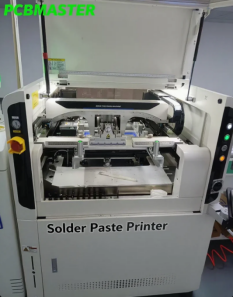
Function: Like a high-precision screen printer, it precisely applies viscous solder paste (a mixture of solder powder and flux) onto PCB pads, laying the foundation for component soldering.
Core Components and Technologies:
·Stencil: A laser-cut stainless steel thin plate with holes corresponding to the positions of PCB pads.
·Squeegee: Typically two in number, responsible for scraping solder paste across the stencil to fill the holes.
·Vision Alignment System: High-resolution cameras identify fiducial marks on both the PCB and stencil to ensure precise alignment.
·Cleaning System: Automatically wipes the bottom of the stencil to prevent residual solder paste from affecting subsequent printing.
·Key Indicators: Precision (±0.025mm or higher), repeatability, printing speed, stencil support method (vacuum/electromagnetic), and cleaning effectiveness.
2. Pick-and-Place Machine
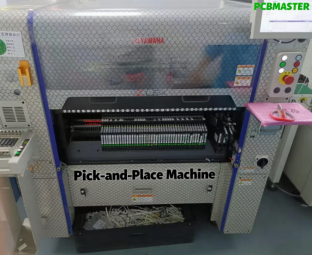
Function: The star of the SMT production line! It picks up components from feeders with extremely high speed and precision, then accurately places them onto the corresponding positions of PCBs coated with solder paste.
Core Types:
·Gantry-type: The most common type. One or more placement heads are mounted on a gantry that moves along the X/Y axes. It offers strong flexibility and high cost-effectiveness.
·Turret-type: A high-speed model. Multiple placement heads are mounted on a high-speed rotating turntable, performing picking, inspection, and placement simultaneously at extremely fast speeds (>50,000 CPH - components per hour).
·Modular Parallel-type: Composed of multiple independent small placement modules that can work in parallel, achieving both high speed and flexibility.
Core Components and Technologies:
·Feeder: Loads components in tape, tube, or tray packaging and supplies them on demand. There are various types (tape, vibratory, tray feeders).
·Placement Head: The core executive component, including vacuum nozzles, detection sensors (vacuum/pressure), and rotating motors. High-end placement heads can automatically and quickly change nozzles to adapt to different components.
·Vision System: The core! It takes high-speed photos of components after picking and before placement: identifying component types, polarity, measuring dimensions, checking pin coplanarity, and detecting nozzle position offsets. It real-time corrects the placement position (X, Y, θ, Z) based on visual feedback.
·Motion Control System: Ultra-high-precision servo motors and guide rails ensure fast, smooth movement and precise positioning.
·Key Indicators: Placement speed (CPH), placement accuracy (Cpk value, usually requiring >1.33, indicating extremely high stability), range of handleable components (from smallest 0201/01005 chips to large BGA/QFN/connectors), feeder capacity, changeover time, and software usability.
3. Reflow Soldering Oven
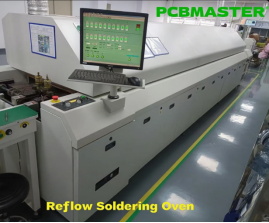
Function: Bringing solder paste "to life"! It heats PCBs with mounted components according to a precisely controlled temperature profile, melting (reflowing) the solder paste to wet the pads and component pins, forming reliable electrical and mechanical connections after cooling.
Core Structure: A tunnel-type heating furnace consisting of multiple temperature zones.
Temperature Zones and Functions:
·Preheating Zone: Raises temperature slowly to activate flux, evaporate solvents, and prevent thermal shock.
·Soak/Activation Zone: Evens out the PCB temperature and allows flux to fully clean the pads.
·Reflow Zone: Reaches peak temperature (usually 20-40°C above the solder melting point), ensuring complete melting of the solder paste to form joints.
·Cooling Zone: Controls the cooling rate to form a dense and reliable solder joint microstructure.
Heating Technologies:
·Hot Air Convection: The most mainstream method, heating via high-temperature hot air circulation, offering good temperature uniformity.
·Infrared (IR) Radiation: Heats quickly but may cause temperature differences due to varying heat absorption efficiency of components with different colors/materials.
·Vapor Phase Soldering (VPS): Uses latent heat from specific liquid vapor for heating, providing extremely uniform temperatures, suitable for high-reliability products but with high costs and strict environmental restrictions.
·Hot Air + IR Hybrid: Combines the advantages of both.
·Key Indicators: Number of temperature zones, heating length/cooling capacity, temperature control accuracy, temperature uniformity (±1-2°C), nitrogen protection capability (reducing oxidation to improve soldering quality), thermal compensation capability, energy consumption, and software (real-time monitoring and optimization of temperature profiles).
4. SMT Inspection Equipment
Function: The "eyes" ensuring quality, inspecting potential defects after key processes.
Main Types:
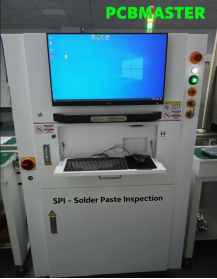
·Solder Paste Inspection (SPI): After printing, uses 3D optical scanning (e.g., laser triangulation, fringe projection) to measure solder paste volume, height, area, shape, and position offset. It timely detects printing defects (insufficient solder, excess solder, bridging, offset) to prevent defects from entering subsequent processes.
·Automated Optical Inspection (AOI):
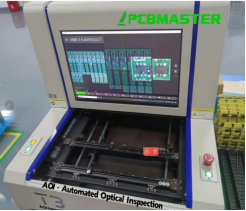
Usually used before reflow (to check placement) and after reflow (to check soldering). It captures PCB images from multiple angles using high-resolution cameras and compares them with standard images or CAD data to detect defects such as missing components, wrong components, reversed polarity, offset, tombstoning, bridging, and cold solder joints. It relies on powerful algorithms and light source combinations.
·Automated X-ray Inspection (AXI): Inspects hidden solder joints (e.g., BGA, QFN bottom joints, PCB inner-layer connections) through penetration. It detects defects like solder joint voids, bridging, open circuits, and insufficient solder. It is a key equipment for inspecting high-density complex packages, available in 2D and 3D (CT tomography) versions.
THT (Through-Hole Technology) Equipment: Continuation of Classic Technology
Although SMT is mainstream, THT remains important for connectors, high-power components, and special switches.
1. Auto Insertion Machine
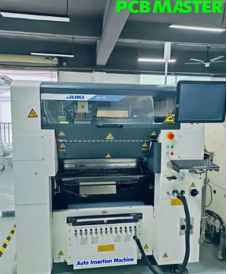
Function: Automatically inserts axial (resistors, capacitors) or radial (diodes, inductors) leaded components into PCB through-holes.
Types:
·Sequential: Inserts components one by one, with relatively slow speed.
·Simultaneous: Inserts multiple components at once, offering high efficiency.
·Key Components: Component feeders, lead cutting/bending mechanisms, insertion heads, and PCB conveying devices.
2. Wave Soldering Machine
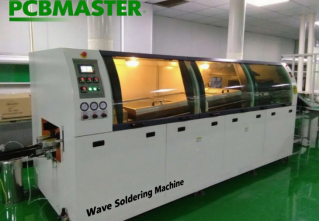
Function: Solders PCBs with inserted THT components. The bottom of the PCB passes through a "wave" of molten solder, which climbs to wet the leads and pads inside the through-holes.
Core Structure:
·Flux Spraying Zone: Sprays flux to clean pads and leads.
·Preheating Zone: Preheats the PCB to prevent thermal shock and activate flux.
·Soldering Zone: Molten solder is pumped to form a stable "wave" (single wave or dual wave - turbulent wave + smooth wave), and the PCB conveyor passes through the wave at a constant speed.
·Cooling Zone: Cools and solidifies the solder joints.
·Key Indicators: Wave flatness, temperature control accuracy, nitrogen protection capability, solder oxidation resistance, dross generation rate, and flux spraying control precision.
3. Selective Wave Soldering Machine
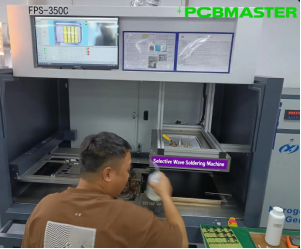
Function: Solves the problem that traditional wave soldering cannot solder local areas. It uses small movable nozzles to precisely jet molten solder onto specific through-hole points that need soldering. Suitable for hybrid technology boards (SMT + a small number of THT), large boards, or soldering in heat-sensitive areas.
Advantages: Small solder contact area, low thermal stress, and reduced solder and flux consumption.
Building Efficient Production Lines - Equipment Selection and Configuration Strategies
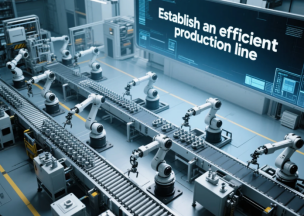
Selecting the right equipment is essential for building efficient production lines in PCB assembly. Factors such as speed, accuracy, and flexibility should be considered to ensure optimal performance.
Effective inventory management of components and materials is also crucial for maintaining efficient production lines and minimizing downtime.
1. Pre- and Post-Assembly Auxiliary Equipment: Process Guarantees
·Loader/Unloader: Automatically feeds empty PCBs into the production line and removes fully assembled PCBs.
·Buffer Conveyor: Connects different equipment, balances production line tempo, and provides buffering.
·Depaneler: Separates multiple PCBA units on a panel. Methods include router cutting, V-cut depaneling, and laser cutting.
·Cleaning System: Removes residual flux and contaminants after soldering (especially for high-reliability products). Methods include water-based cleaning, semi-aqueous cleaning, and solvent cleaning.
·Conformal Coating Equipment: Sprays, dips, or brushes a protective coating on the PCBA surface to resist moisture, corrosion, dust, and salt spray. It includes dispensers, selective sprayers, and dipping equipment.
·Curing Oven: Cures conformal coatings, underfill adhesives, and solder pastes.
·Rework Station: Used for manual or semi-automatic repair of defective components (especially BGA, QFN, etc.), including precision heating heads (hot air, infrared), microscopes, and alignment systems.
2. Clarifying Product Requirements - The Starting Point
Selecting equipment is not simply about “buying the most expensive” or “the cheapest”; it is a systematic project requiring careful consideration:
·Product Type and Complexity: Consumer electronics? Automotive electronics? Medical devices? Military products? Board size, number of layers, component density (especially fine-pitch BGA/QFN), smallest component size (01005? 0201?), and ratio of hybrid technologies (SMT/THT).
·Production Volume and Capacity Requirements: Small-batch, multi-variety? Or large-batch, single-variety? Expected daily/monthly/annual output directly determines the number and speed requirements of equipment.
·Quality and Reliability Standards: Need to meet IPC-A-610 Class 2/3? Automotive electronics IATF 16949? Medical ISO 13485? Aerospace AS9100? High standards require more precise equipment and stricter inspection.
·Budget Constraints: Both initial investment budget and long-term operating costs (consumables, maintenance, energy) need to be considered.
·BOM (Bill of Materials) Accuracy: An accurate BOM is essential to ensure all required components are accounted for, supporting effective cost control and production planning.
3. Key Points for Core Equipment Selection - In-Depth Analysis
Placement Machines:
·Spee vs. Flexibility: Turret machines are fast but may have slightly longer changeover times than gantry machines; modular machines balance both but cost more. Evaluate product changeover frequency.
·Accuracy and Stability: Focus on Cpk value (process capability index), requiring >1.33 or even >1.67 to ensure long-term stable production with high yield. Inspect vision system performance and motion control precision.
·Component Compatibility: Ensure stable handling of all required component types and sizes, especially the smallest components and odd-form components (large connectors, shields). Feeder compatibility (8mm, 12mm, 16mm, 24mm, tube, tray) is crucial.
·Software and Programming: Is the software easy to learn and use? Does it have offline programming capabilities? Optimization functions (e.g., optimizing placement sequence to reduce gantry movement distance)? Integration capability with MES systems?
Reflow Ovens:
·Number and Length of Temperature Zones: Complex boards or large boards require more temperature zones (e.g., 10-14 zones) and longer heating/cooling zones to achieve precise temperature profiles.
·Temperature Control Precision and Uniformity: ±1-2°C is a high-end requirement. Hot air circulation design affects uniformity.
·Nitrogen Capability: For soldering high-reliability products or using lead-free solder (prone to oxidation), nitrogen protection (oxygen content <1000ppm) can significantly improve soldering quality.
·Energy Consumption: Reflow ovens are major energy consumers; energy-saving designs (insulation materials, high-efficiency fans, waste heat recovery) can save significant costs in the long run.
Inspection Equipment (SPI/AOI/AXI):
·Inspection Capability: 3D measurement precision of SPI? Algorithm capability and false call rate of AOI? 2D or 3D AXI? What is the resolution? Can it cover all key defect types?
·Speed: Inspection speed must keep up with the production line tempo and not become a bottleneck.
·Software and Analysis: Does it provide detailed defect classification statistics, process control charts (SPC), and root cause analysis assistance? Can data be uploaded to MES?
Solder Paste Printers:
·Alignment Precision: The precision of the vision alignment system is key.
·Stability: Squeegee pressure control and stencil support method (electromagnetic/vacuum) affect printing consistency.
·Cleanng Efficiency: The thoroughness and frequency of automatic cleaning are crucial for preventing printing defects.
4. Production Line Balancing and Efficiency - Eliminating Bottlenecks
·Theoretical Capacity Calculation: Calculate the cycle time of each device (especially placement machines and reflow ovens) to identify the slowest link (bottleneck).
·Line Balancing: Balance the time of each workstation by adjusting the number of equipment (e.g., adding a placement machine), optimizing programs (e.g., optimizing placement paths), and setting reasonable buffer zones (buffer conveyors) to ensure smooth operation of the entire line and maximize equipment utilization (OEE).
·Changeover Time: For multi-variety production, quick changeover capability (SMED - Single Minute Exchange of Die) is extremely important. Choose equipment with easy changeover (e.g., quick-change feeder systems) and optimize changeover processes.
5. Supplier Evaluation and Service Support
·Brand Reputation and Market Share: Mainstream brands (e.g., placement machines: ASM Siplace, Fuji NXT, Panasonic, Yamaha, JUKI, Mycronic, Europlacer; reflow ovens: Heller, Rehm, BTU; inspection equipment: Koh Young, Mirtec, Omron, ViTrox) usually have mature technology and high reliability.
·Local Technical Support and Service: Is there a strong local service engineer team? Are spare parts inventories sufficient? What is the response time? What is the price of service contracts? Reliable after-sales service is key to ensuring production continuity.
·Technical Training: Does the supplier provide comprehensive training on operation, programming, and maintenance?
Cutting-Edge Trends and Future Outlook - Rise of Smart Manufacturing

The field of PCB assembly equipment is undergoing profound changes, with the main directions being smarter, more flexible, more efficient, and greener.
Leading PCB assembly equipment brands are recognized and trusted by manufacturers around the world, supporting global electronics production.
1. In-Depth Penetration of Smart Manufacturing
·IoT-Enabled Equipment: Equipment is equipped with rich sensors to collect real-time operating parameters (temperature, pressure, speed, vibration, energy consumption, component rejection rate, false call rate, etc.).
·Data-Driven Decision-Making (Big Data & Analytics): Integrate equipment data through MES (Manufacturing Execution System) and factory-level SCADA systems for real-time monitoring, predictive maintenance (warning before equipment failure), quality traceability, process optimization (e.g., automatically fine-tuning reflow profiles based on ambient temperature and humidity), and capacity analysis.
·Digital Twin: Build a virtual model of the production line to simulate the introduction of new processes and products, optimize production parameters, and reduce physical trial-and-error costs.
2. Ultimate Flexible Production
·Modular Equipment Design: Equipment functions are modular, facilitating rapid combination or upgrading according to needs.
·Faster Changeover Capability: Smarter feeder management systems, automatic nozzle replacement, and more advanced software-assisted changeover.
·Collaborative Robots (Cobots): Collaborate with humans in loading/unloading, depaneling, simple assembly, and inspection stations to improve flexibility in small-batch, customized production.
3. Intelligent Upgrades in Inspection Technology
·AI-Driven AOI/AXI: Use deep learning algorithms to significantly reduce false call rates and escape rates, improve inspection efficiency and accuracy, and reduce manual re-judgment workload.
·Multi-Modal Inspection Integration: Comprehensive analysis and defect judgment by combining data from multiple inspection methods (AOI for appearance, AXI for internal, flying probe testing for electrical performance).
·Online SPC and Closed-Loop Control: Real-time feedback of SPI inspection results to the printer, automatically adjusting squeegee pressure, speed, and demolding parameters to achieve closed-loop control of printing quality.
4. Precision and Miniaturization
·Higher Precision Requirements: With the popularity of 01005, 008004 components, and even smaller chips, as well as the application of SiP (System-in-Package), the precision requirements for placement machines and printers continue to increase.
·Support for Advanced Packaging: Equipment needs to adapt to assembly requirements of advanced interconnection technologies such as Flip Chip, Wafer-Level Packaging (WLP), and 2.5D/3D packaging, which may require more precise dispensing (underfill), Thermocompression Bonding (TCB), laser-assisted bonding, and other special process equipment.
5. Green Manufacturing and Sustainable Development
·Energy Consumption Reduction: Equipment manufacturers continue to optimize the heating efficiency, insulation performance, and cooling systems of reflow ovens and wave soldering machines, significantly reducing energy consumption. High-efficiency motors and variable frequency drives are widely used.
·Waste Reduction: Promote no-clean flux processes; optimize solder paste printing to reduce waste; improve wave soldering design to reduce dross generation; adopt solder recycling technologies.
·Eco-Friendly Materials: Explore lead-free solders with lower melting temperatures (reducing energy consumption and thermal damage) and water-based cleaning agents instead of solvent-based ones.
Return on Investment and Long-Term Value - More Than Just Buying Equipment
Purchasing PCB assembly equipment is a significant capital investment. A wise decision requires considering the Total Cost of Ownership (TCO):
·Initial Purchase Cost: Equipment price, tariffs, transportation, installation, and commissioning costs.
·Operating Costs: Electricity consumption (reflow ovens and wave soldering machines are major energy users), process consumables (solder paste, solder bars, flux, stencils, nozzles, cleaning agents), maintenance spare parts, service contract fees, and labor costs for operators and engineers.
·Maintenance and Upkeep: Regular preventive maintenance (PM) is crucial for maintaining equipment precision, stability, and extending service life. Neglecting maintenance can lead to frequent failures, reduced yield, and soaring costs. Choosing suppliers with good service support can significantly reduce maintenance difficulties and costs.
·Depreciation and Update Cycle: Equipment technology iterates rapidly (especially software and inspection technology), so a reasonable update cycle (usually 5-10 years) should be planned to balance technological advancement and return on investment.
·Qality Costs: Investment in high-quality equipment and inspection can significantly reduce hidden costs caused by defects, such as rework, scrap, customer returns, and reputation damage. The loss from a single serious quality accident may far exceed the value of the equipment itself.
To better understand the total cost of ownership for your specific PCB assembly equipment needs, you are welcome to request a personalized quote tailored to your requirements.
Introduction to Well-Known PCB Assembly Equipment Brands
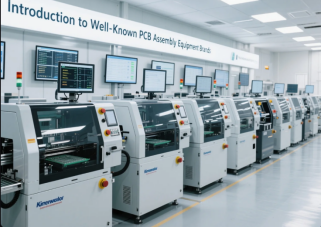
These leading brands have decades of experience in developing and manufacturing PCB assembly equipment, ensuring reliability and innovation.
When it comes to PCB assembly equipment, several well-known brands stand out in the industry. These brands are recognized for their quality, advanced technology, and commitment to customer satisfaction.
1. Solder Paste Printing Equipment
Solder paste printing is the first step in SMT (Surface Mount Technology) and directly affects soldering quality. Mainstream equipment includes:
·MPM Accela (USA): Known for high speed and precision, supporting 01005 component printing, suitable for high-yield scenarios.
·DK Horizon (UK): Adopts intelligent squeegee technology, which can automatically adjust pressure to reduce solder paste waste.
·Koh Young Zenith (South Korea): Integrates 3D SPI (solder paste inspection) function to real-time monitor solder paste thickness and shape, reducing defect rates to below 0.1%.
2. Placement Machines
Placement machines are the core of SMT production lines, divided into high-speed machines and multi-functional machines according to functions:
·Yamaha YSM20R (Japan): Equipped with a dual cantilever structure, the placement speed reaches 56,000 CPH (components per hour), supporting 01005 to 55mm×55mm components, widely used in consumer electronics and automotive electronics.
·Panasonic NPM-W2 (Japan): Modular design, flexibly configurable placement heads, supporting odd-form components and BGA, suitable for high-mix production.
·Hanwha SM481 (South Korea): 2025 new model, adopting a 10-head single-beam design, with a placement accuracy of ±50μm, optimized for 5G communication and AI servers.
3. Soldering Equipment
Soldering equipment is divided into reflow ovens and wave soldering machines, applicable to SMT and through-hole components respectively:
·BTU Pyramax (USA): Reflow oven adopts infrared + hot air hybrid heating technology, with temperature uniformity of ±2°C, supporting lead-free soldering and nitrogen protection.
·Electrovert Vectra Elite (USA): Wave soldering equipment is equipped with dynamic solder waves, reducing bridging and cold solder joints, suitable for high-reliability requirements such as automotive electronics.
·Pillarhouse Pilot (UK): Selective soldering equipment supports local heating, reducing energy consumption by 30%, suitable for small-batch, high-precision scenarios such as medical devices.
4. Inspection Equipment
·Koh Young Aspire 3 (South Korea): 3D AOI inspection equipment, adopting multi-angle imaging technology, can detect tiny defects of 0.01mm with a false call rate below 0.5%.
·Nordson DAGE Quadra 5 (UK): X-ray inspection equipment penetrates the interior of PCBs to detect BGA and hidden solder joint defects, widely used in the aerospace field.
Advantages of Equipment from Various Brands
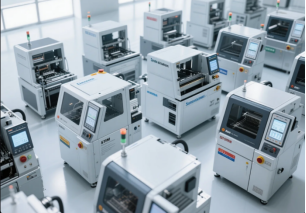
1. Japanese Brands
·Yamaha: With servo motor technology, its placement machines lead the industry in precision. The YSM series holds over 30% market share in the mid-to-high-end market.
·Panasonic: The NPM series is known for modular design and intelligent software (e.g., AI path optimization), suitable for complex product production.
·Jui: The RS-2 series placement machines are renowned for low maintenance costs and high stability, making them one of the preferred brands for small and medium-sized enterprises.
2. South Korean Brands
·Hanwha: The SM series placement machines adopt dual vision systems, supporting 01005 components and 0.3mm pitch QFP. Its global market share grew to 15% in 2025.
·Samsung: The DECAN series placement machines are equipped with laser height detection technology, increasing component recognition speed by 40%, with outstanding performance in the consumer electronics field.
3. European and American Brands
·ASM PT (Singapore): The Siplace SX series placement machines support multi-variety mixed production, integrating Industry 4.0 interfaces, suitable for smart factories.
·Heler (USA): Reflow ovens are famous for temperature control precision (±1°C) and long service life (over 10 years), with a market share of over 40% in the automotive electronics field.
4. Other Brands
·Manncorp (USA): Pre-configured production lines (e.g., Advanced Starter Line) offer high cost-effectiveness, supporting small and medium-sized enterprises to quickly establish production capacity.
·Neoden (China): The YY1 series placement machines cost only 1/3 of Japanese brands, especially suitable for prototype development in research institutions and start-ups.
Equipment Maintenance and Upgrades
1. Daily Maintenance Points
·Placement Machines: Clean nozzles and guide rails daily, check belt tension (tension meter recommended), and replace vacuum pump oil regularly.
·Reflow Ovens: Clean solder dross in the furnace weekly, calibrate temperature sensors (error <±2°C), and check nitrogen flow.
·AOI Equipment: Clean lenses and light sources monthly, and update defect databases to improve recognition accuracy.
2. Upgrade Strategies
·Software Updates: Placement machines (e.g., Yamaha YSM series) support new component types through firmware updates; reflow ovens (e.g., Heller 1913 MK5) can add AI temperature prediction functions.
·Hardware Modifications: Old placement machines can be equipped with vision systems (e.g., Mycronic Jet Printer) to achieve high-speed dispensing and expand functions.
3. Cost Optimization
·Leasing Model: Small and medium-sized enterprises can adopt Manncorp's equipment leasing service to reduce initial investment risks. ·Used Equipment: Certified refurbished equipment (e.g., Juki FX series) costs only 60% of new machines, with performance close to original factory standards.
Frequently Asked Questions (FAQs)
Q: How to choose a suitable placement machine?
A: Consider production volume (high-yield for high-speed machines, small-batch for multi-functional machines), component types (01005 requires high-precision equipment), and budget. For example, Yamaha YSM20R is suitable for medium-to-high yield, while Manncorp’s manual placement machines are suitable for prototyping.
Q: What are the common causes of poor solder paste printing?
A: They may include unreasonable stencil aperture design, uneven squeegee pressure, and abnormal solder paste viscosity. It is recommended to use SPI equipment for real-time monitoring and parameter optimization.
Q: How to reduce AOI false call rates?
A: Regularly update inspection algorithms, adjust thresholds (e.g., relax grayscale tolerance from ±10% to ±15%), and introduce machine learning models (e.g., Cogiscan TTC) to improve recognition accuracy.
Q: How to set reflow temperature profiles?
A: Adjust according to component types (e.g., BGA requires higher peak temperature) and PCB thickness. Usually, the heating rate is controlled at 2-3°C/second, peak temperature at 245-255°C, and cooling rate at 4-6°C/second.
Q: What is SMT assembly and what equipment is required?
A: SMT assembly (Surface Mount Technology assembly) is the process of mounting electronic components directly onto the surface of a PCB. The main equipment required for SMT assembly includes solder paste printers, pick and place machines, reflow ovens, and AOI (Automated Optical Inspection) systems.
Q: What equipment do you recommend for small-scale or limited-space production?
A: For small-scale or limited-space production, we recommend compact or manual SMT assembly equipment such as desktop pick and place machines, small reflow ovens, and manual stencil printers. We can provide personalized recommendations based on your specific production needs.
If you have more questions or need a personalized quote, get in touch with us today to learn more about SMT assembly and PCB assembly equipment.
Conclusion
PCB assembly equipment is the core productivity of electronic manufacturing, and its technological progress directly drives industry development. By gaining an in-depth understanding of equipment types, brand characteristics, industry applications, and maintenance strategies, enterprises can optimize production processes, reduce costs, and enhance competitiveness. In the future, with the popularization of AI, automation, and green manufacturing technologies, PCB assembly equipment will evolve towards smarter, more efficient, and more environmentally friendly directions, bringing new opportunities and challenges to the electronics industry.
Why PCBMASTER: https://www.pcbmaster.com/why
Join US:https://www.pcbmaster.com/login
